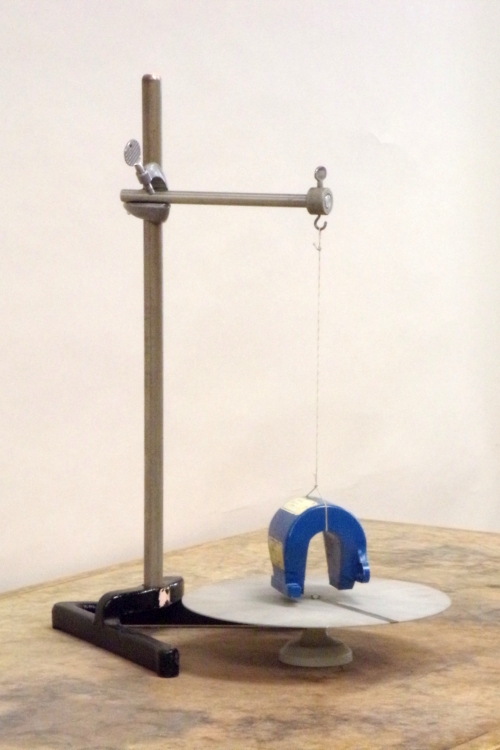
When you give the suspended U magnet a sudden twirl, eddy currents induced in the disc interact with the field of the spinning magnet, causing the disc to turn (in the same direction). Conversely, if you give the disc a quick spin, the interactions of the currents induced in the spinning disc with the field of the magnet cause the magnet to turn (in the same direction).
A U magnet is suspended above an aluminum disc, which is mounted on a pivot at the center, about which it can rotate. The magnet is set high enough that the class can see that it does not touch the disc, but it is still close enough to the disc for a significant portion of the magnetic field to penetrate the disc. A black stripe along a radius of the disc makes its rotational motion easy to see. As the magnet sits in the photograph, the pole on the left is the north pole, and the one on the right is the south pole. The magnetic field lines leave the north pole, pass through the disc, then return through the disc to the south pole. When you spin the magnet, the magnetic field passing through the disc under each pole, induces an EMF in the area of the disc that is underneath that pole. If you spin the magnet clockwise (as viewed from the top), the field under the north pole induces an EMF that causes (positive) charges in the disc to flow radially inward, and the field underneath the south pole induces an EMF that causes charges to flow radially outward. (As the magnet spins, the charges in the disc have a velocity that is counterclockwise relative to the magnet. At the north pole, where the field points down, this results in a force, F = qv × B, which points radially inward, and at the south pole, where the field points up, qv × B points radially outward.) The areas to either side of each pole provide return paths for the radially-flowing charges, and at each pole this produces two sets of currents. At the north pole, where the radial flow is inward, in front of the pole the currents flow counterclockwise, and behind the pole they flow clockwise. At the south pole, where the radial flow is outward, in front of the pole the currents flow clockwise, and behind the pole they flow counterclockwise. Such currents induced in an extended object (as opposed to a ring or a loop of wire) are called eddy currents.
The charges flowing radially inward under the north pole experience a force, F = qv × B, which points clockwise. For the charges flowing radially outward under the south pole, since both v and B are opposite to those at the north pole, qv × B still points clockwise. The other parts of the eddy currents are outside the magnetic field, so they do not experience such a force, and there is a net clockwise force on the disc at each pole. Since the disc is free to rotate on its pivot, these clockwise forces rotate the disc in the clockwise direction, which is the same direction in which the magnet is spinning in our example. The black stripe along a radius of the disc makes the rotation obvious to the class.
If instead of spinning the magnet, you give the disc a quick spin, the same process occurs. If you spin the disc in the clockwise direction, beneath the north pole, the induced EMF causes charges to flow radially outward, and at the south pole it causes them to flow radially inward. At the north pole, then, if we look outward along the radius, the set of currents to the left circulates in the counterclockwise direction, and those to the right circulate in the clockwise direction. At the south pole, if we look outward along the radius, the currents on the left flow in the clockwise direction, and the currents on the right flow in the counterclockwise direction. The outward-flowing charges at the north pole experience a force, F = qv × B, which points in the counterclockwise direction, and the inward-flowing charges at the south pole also experience a force that points counterclockwise. These forces oppose the motion of the disc, and would normally slow it. Since the magnet is suspended so that it can rotate freely, however, instead of these forces merely slowing the disc, they also turn the magnet, which begins to rotate in the same direction as the disc. This constitutes a type of magnetic clutch or drive called an eddy current clutch or eddy current drive. This type of drive is widely used in industry. For example, see the Dynamatic web site or the Ideal Electric web site.
References:
1) Sears, Francis Weston and Zemansky, Mark W. College Physics, Third Edition (Reading, Massachusetts: Addison-Wesley Publishing Company, 1960) p. 672-3.
2) Halliday, David and Resnick, Robert. Physics, Part Two, Third Edition (New York: John Wiley and Sons, 1977), pp. 787, 791.